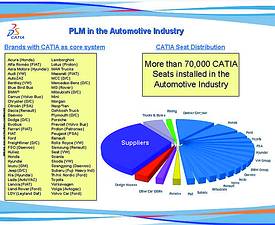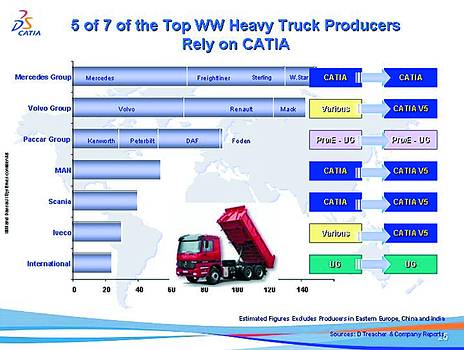A challenge for motor manufacturers
October 2004
With fierce competition forcing vehicle manufacturers to reduce time-to-market to less than two years, the worldwide automotive industry is facing intense challenges.
These issues and possible solutions were addressed at a seminar hosted by IBM South Africa and CDC (CNC Design Consultants) at Automotive Supplier Park in Pretoria in August.
IBM SA's Rui Mendes says the focus was on giving delegates an understanding of how to address real-world engineering challenges by using technology to shorten lead times, reduce costs, increase product quality and reliability and raise productivity.
"The only way to achieve the drastic reduction in development time the industry is demanding is to introduce high levels of standardisation, design and manufacturing automation, coupled with close collaboration throughout the supply chain," Mendes says.
"Computer-based integration of design and manufacturing is essential for the '24-month car' to be achieved. This time-to-market reduction affects not only the manufacturers, but everyone in the extended manufacturing process."
As the worldwide marketer of CATIA (computer aided three-dimensional interactive application), the CAD solution from Dassault Systemes in France, IBM partners locally with CDC, a leading supplier of CAD and CAM products to the South African industry.
The seminar emphasised the use of CATIA's innovative Generative Tooling technology, which enables the automated design of jigs, fixtures, moulds and dies directly from the components of the finished product.
Igal Filipovski, managing director of CDC, says CATIA's Generative Tooling Design is the practice of duplicating an existing, already validated toolset model into a product and process context. Once this has been done, the tooling models are adjusted to take into account the new physical context. This adjustment must be as fast as possible and above all, it must comply with technology rules. At the end of this process is a new validated toolset.
"In the same way that standardisation was introduced into vehicle design to save time and money, standardised or 'generic' tooling needs to be introduced into production engineering so that standard tooling can be adapted and modified quickly and effectively for each new product iteration," Filipovski explains.
"When the underlying design has been done with state-of-the-art technology like IBM's CATIA Version 5, fundamental changes can be automated, thereby saving time and money."
The cornerstone of a true integration of people, tools, methodologies and resources in an enterprise, CATIA has a built-in capacity to capture and re-use knowledge that drives the implementation of corporate design best practice and frees end users to focus on creativity and innovation.
The system also has a technology called Knowledgeware, which runs in the background and helps users adhere to company standards without having to specifically check for compliance. If a designer strays outside accepted 'best practice', Knowledgeware warns him and ensures that the design remains compliant.
There are more than 70 000 CATIA seats installed in the global automotive industry. In South Africa, the CATIA customer base includes BMW, Daimler-Chrysler, Delta, Toyota and Volkswagen.
For more information contact Igal Filipovski, CDC, 011 786 3516, igal@cdcza.co.za, www.cdcza.co.za
Others who read this also read these articles
Prominent new lifestyle centre for Cape Town's financial district
Dimension Modeling created the 3D interior models that were then also rendered out for internal views of the apartments as well as the atrium and foyer areas[ August 2004 ]
Anglo Platinum - automating repetitive design tasks with Solid Edge
Solid Edge Insight is an innovative solution that seamlessly integrates CAD, design management and Web-based collaboration into a single tool that is easy to implement and easy to manage[ June 2004 ]
Styled plastic products and packaging - main pains and solution initiatives
To put the product and the customer front and centre, where they belong, all disciplines must sit at the same virtual table, sharing the same information and seeing the same vision[ June 2004 ]
Evolution from 2D to 3D - a product development manager's perspective: Part II
Whereas 2D CAD shortens time scales to some extent, 3D CAD goes much further, directly supporting the whole product development cycle, speeding up every activity and increasing the quality of design by removing many sources of inaccuracy and error[ April 2004 ]
Multiphysics analysis to simulate cylinder head
Adiabatics Inc used multiphysics FEA software from Algor to study the thermal and structural behaviour of a cylinder head for a diesel engine that would provide reduced heat rejection and increased power density while maintaining its superior fuel economy and lower operating cost[ December 2003 ]
Unigraphics NX 2: the next generation
What the NX 2 release sees is the integration of the use of networks of curves to define surface boundaries and existing geometry, and freeform surface modelling into the core of Unigraphics but with a few rather neat extras as well[ October 2003 ]
Geopak helps create Festival City
Geopak Site allows one to handle with ease live 'what if' scenarios with the client and other design team members[ August 2003 ]
Desktop product has new features and enhancements
Engineers can accurately and quickly simulate one body rolling or sliding on another body, in three dimensions such as in cam and latch designs[ August 2002 ]
Others who read this also read these news items
Lockheed Martin selects preferred MCAD tool
[ December 2005 ]
Grand scale initiatives at Ethekwini Municipality
[ October 2005 ]
Robert Mugabe Avenue in Windhoek gets extension
[ August 2005 ]
Strand7 nonlinear analysis used to solve bracket deformation problem
[ August 2005 ]
Scania optimises truck components
[ February 2005 ]
Delcam's PowerMILL chosen for A1 Grand Prix engine manufacture by Zytek
[ February 2005 ]
A first of its kind: irrigation development, a R3,7-billion SADC project
[ February 2005 ]
Arup lands Tianjin Olympic Aquatic Centre project
[ December 2004 ]
Others who read this also read these regulars
Search Site
Subscribe
Previous Issues
Other Technews Publications
Other Technews Buyers Guides
 |  | Copyright c1995-2009 Technews Publishing (Pty) Ltd.. All rights reserved. |

